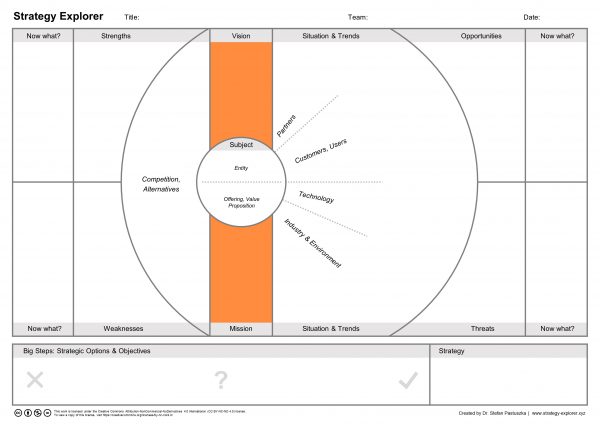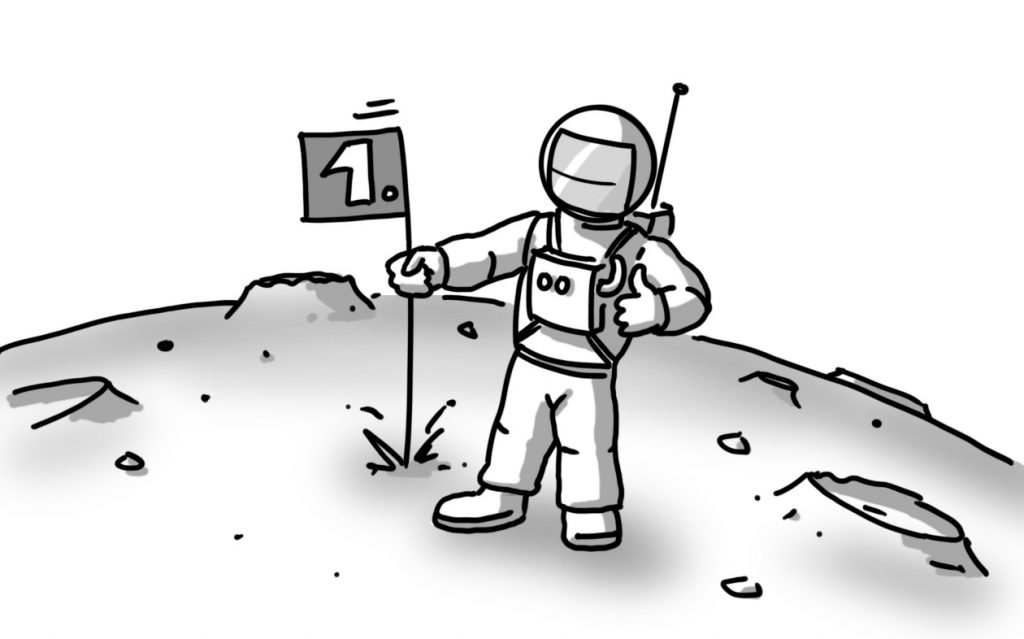Strategy development needs a clear goal – otherwise, it will be difficult to devise the proper way to achieve, well, what exactly? By definition, a strategy is a long-term plan to achieve a specific goal. There are other definitions, but this is the simple, common denominator. Therefore, before devising a strategy, a goal needs to be specified. This is step 2 in the process with the Strategy Explorer.
When thinking about the goal, this means that you need to make up your mind about Vision and Mission, two well-known notions in the world of strategy. Despite these two words themselves are quite famous, their meaning is often interpreted differently, leading to vision and mission being mixed up or even swapped. Nonetheless, both elements are important for strategy development. For our purposes, we will go with the following distinction:
- Vision: a picture of the future from today’s perspective.
- Mission: the purpose of your subject (company, etc.), the reason why it exists.
In strategy development, the mission provides the general direction in which to move – like a north star that points the way but will never be reached. In contrast, the vision depicts a concrete future at a given point of time (e.g., five, ten or more years into the future) and specifies the overarching goals that you strive to achieve. While the vision can change to reflect certain developments, the mission of an organization is typically deeply ingrained and should be valid over a long period of time.
A simple example: If you are, say, a non-profit organization striving to “provide medical aid to the poor” (your mission), this will provide guidance for all strategic decisions. The people working in your organization ideally identify themselves with that mission and want to help fulfill it. Therefore, it will be difficult to change the mission substantially without exchanging or slowly transforming your organization. On the other hand, your vision might be that in the year X you will be able to serve Y percent of a certain population and everybody knows your organization. This vision provides goals to be achieved come the year X and can of course be adapted.

Mission
Surely, a strategy can be developed without meticulously specifying the own mission, but clarifying the purpose of an organization helps a lot. It will be both useful for the motivation of the employees as well as for communication with the outside world. As it provides guidance for all strategic decisions, it should not be formulated too narrowly. Indeed, a good mission leaves enough room to think broadly about the future development of, e. g., an organization, while at the same time helping to decide what not (!) to do. An excellent example in this context is the original mission of Walt Disney: “to make people happy.” It did not specify the production of cartoons and movies or the opening of theme parks. Instead, all these possible activities bring the mission to life and there is still room for a fruitful further development. Ideally, the mission statement is not just a nice sounding “marketing” phrase, but really describes the purpose of an organization. It should be authentic and motivating and the employees should be proud to use it to explain what the company they work for is doing (Collins & Porras).
If you already have a ready-made mission statement for your part of the organization, simply copy it into the field “Mission” on the Strategy Explorer. If you have to create one from scratch, one way would be to first have everybody on the team write down his or her take on the mission statement separately. Then find out which of the statements resonate most with the team and try to condense these favored statements into a new, single one.
Vision
As described earlier, the vision is a picture of the future from today’s perspective. This can be taken quite literally: In order to motivate people, it helps to have a clear picture in everybody’s mind showing what has to be achieved. An excellent example for such a picture is the proverbial “man on the moon”, as mentioned by President John F. Kennedy in his famous 1961 speech: “I believe that this nation should commit itself to achieving the goal, before this decade is out, of landing a man on the moon and returning him safely to the earth.” This way, he provided an excellent vision for NASA. At the same time, this formulation fulfills all criteria for being a SMART goal, including timing. Especially, it is sufficiently ambitious to qualify as visionary (not exactly a safe bet).

Typically, the vision of the future is a complex picture that can cover a number of different aspects: how does the future look like, how have we helped to make it real, how do we fare in this future, how does our organization look like, how do we work, etc. Of course, this has to be focused and narrowed down to a few relevant, overarching goals for communication and effective strategy development. I often work with organizations to actually create a rich picture of the future and use this to distill the essence and derive clear goals. This way, they are much easier to identify than by trying to formulate them from the top of the hat. If you do not have sufficient time for a dedicated vision workshop, try to dream up the future of your subject by aggregating the individual input of the team members, e. g. by means of brainwriting with subsequent collection, discussion and clustering of the notes. This way, you will quickly create an ad hoc picture (not literally) of the future that should contain the relevant overarching goals.
Once you have identified these overarching goals: enter them into the “Vision” field on the Strategy Explorer. Typically these are only a few adhesive notes which might read “we are market leader in X”, “everybody knows us for our Y”, “we have subsidiaries on every continent”, “we have won the ‘great place to work’ award”, etc.
Do not underestimate
If you are in the lucky position that you are developing a strategy for an entity with ready-made and available vision and mission statements, it is easy to transfer them to the Strategy Explorer, maybe with slight modifications or adaptations. However, this is seldom the case. If you are, e. g, developing a strategy for a department within a larger company, you will need to create your own vision and mission that fits to both the department and supports the overall vision and mission of the company.
However this may be, the work on vision and mission should not be underestimated. It is important to get at least the vision sufficiently right before you start into the strategy development process. The vision is leading the thoughts for the whole process, therefore all the subsequent work might be in vain when you start off with the wrong goal. In other words, if it takes you longer as expected to agree on a common vision, take your time.
Keep moving
On the other hand, if you have the vision already essentially right, do not waste your time by bickering over words or formulations. This is not a marketing exercise. As long as everybody in the team understands what the goal is and it is reasonably well formulated, you can start into the next stages of the strategy development.
Have a fun and fruitful workshop with the Strategy Explorer working on your vision and mission! For all German-speaking readers, I recommend to consult my book “Strategy Explorer – das Strategiewerkzeug für Teams”, as it will go into more detail on vision and mission and provide a number of examples for inspiration. Feel free to let me know your experiences and also what you would like to read about the Strategy Explorer in my next articles.

